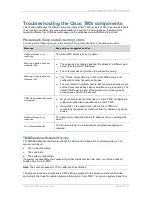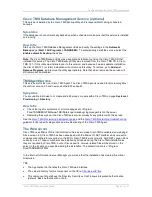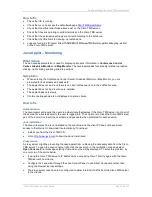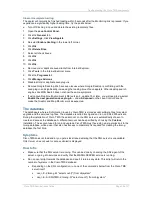
Troubleshooting the Cisco TMS components
Cisco TMS Administration Guide
Page 34 of 37
Slow or incomplete loading
The applet will normally be finished loading within 5 seconds after the Monitoring link is pressed. If you
experience a significantly higher loading time, try the points below:
Turn off Caching in Java and delete the existing temporary files.
1. Open the Java Control Panel,
2. Click the General tab.
3. Click Settings, click View Applets.
4. De-select Enable Caching in the lower left corner.
5. Click Ok.
6. Click Delete Files.
7. Select all check boxes.
8. Click Ok.
9. Click Ok.
10. Click Ok.
Remove old or duplicate Java clients from Internet Explorer.
1. Click Tools in the Internet Explorer menu
2. Click the Programs tab
3. Click Manage Add-ons
4. Disable all old or duplicate Java plug-ins
Remove Google Desktop. We have seen issues where Google Desktop is conflicting with the
Java plug-in and significantly increasing the loading time of Java applets. Other desktop search
engines like MSN Search does not show the same symptoms.
If using Java Runtime Environment (JRE) version 6, update 15 or later, you will need to de-select
Enable the next generation Java plug-in… under Advanced on the Java Control Panel to
make the Graphic and Map Monitor work as expected.
The database
The database is where all information in use by Cisco TMS is stored except software files for system
upgrade and the services’ log files. The database is called tmsng and can run on SQL 2005 servers.
During the installation of Cisco TMS the sa account on the SQL server is automatically chosen to
create and access the database. A different account can be specified by choosing the Custom
installation. The account used to run and upgrade Cisco TMS must have db_owner permissions to the
tmsng database, while a user that also has access to master.mdf is required for creating the tmsng
database the first time.
Symptoms
Cisco TMS does not load and/or you get a stack trace declaring that the SQL server is unavailable:
SQL Server does not exist or access denied is displayed
How to fix
Make sure that the SQL server is running. This can be done by checking the SQL agent of the
server, or going into services and verify that the MSSQLSERVER service is running.
Run an osql script towards the database and see if it returns any data. This script will return the
number of systems in the Cisco TMS database:
•
Depending on the SQL configuration, run one of the commands below from the Cisco TMS
server itself.
•
osql -E -d tmsng -Q "select count(*) from objsystem"
•
osql -E -S .\SQLTMS -d tmsng -Q "select count(*) from objsystem"




































